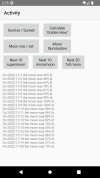Lightweight, only requires Java 8 or higher, no other dependencies. Android compatible, requires API level 26 (Android 8.0 "Oreo") or higher.
Accuracy
Astronomical calculations are far more complex than throwing a few numbers into an obscure formula and then getting a fully accurate result. There is always a tradeoff between accuracy and computing time.
This library has its focus on getting acceptable results at low cost, so it can also run on mobile devices, or devices with a low computing power. The results have an accuracy of about a minute, which should be good enough for common applications (like sunrise/sunset timers), but is probably not sufficient for astronomical purposes.
If you are looking for the highest possible accuracy, you are looking for a different library.
Original library: https://github.com/shred/commons-suncalc
Wrapper is based on v3.5 version.


Accuracy
Astronomical calculations are far more complex than throwing a few numbers into an obscure formula and then getting a fully accurate result. There is always a tradeoff between accuracy and computing time.
This library has its focus on getting acceptable results at low cost, so it can also run on mobile devices, or devices with a low computing power. The results have an accuracy of about a minute, which should be good enough for common applications (like sunrise/sunset timers), but is probably not sufficient for astronomical purposes.
If you are looking for the highest possible accuracy, you are looking for a different library.
Original library: https://github.com/shred/commons-suncalc
Wrapper is based on v3.5 version.


PndCommonsSunCalc
Author: Author: Richard Körber - B4A/B4J Wrapper: Pendrush
Version: 1.0
- PndCommonsSunCalc
- Fields:
- MOONPHASE_PHASE_FIRST_QUARTER As org.shredzone.commons.suncalc.MoonPhase.Phase
Waxing half moon- MOONPHASE_PHASE_FULL_MOON As org.shredzone.commons.suncalc.MoonPhase.Phase
Full moon- MOONPHASE_PHASE_LAST_QUARTER As org.shredzone.commons.suncalc.MoonPhase.Phase
Waning half moon- MOONPHASE_PHASE_NEW_MOON As org.shredzone.commons.suncalc.MoonPhase.Phase
New moon- MOONPHASE_PHASE_WANING_CRESCENT As org.shredzone.commons.suncalc.MoonPhase.Phase
Waning crescent moon- MOONPHASE_PHASE_WANING_GIBBOUS As org.shredzone.commons.suncalc.MoonPhase.Phase
Waning gibbous moon- MOONPHASE_PHASE_WAXING_CRESCENT As org.shredzone.commons.suncalc.MoonPhase.Phase
Waxing crescent moon- MOONPHASE_PHASE_WAXING_GIBBOUS As org.shredzone.commons.suncalc.MoonPhase.Phase
Waxing gibbous moon- TWILIGHT_ASTRONOMICAL As org.shredzone.commons.suncalc.SunTimes.Twilight
Astronomical twilight- TWILIGHT_BLUE_HOUR As org.shredzone.commons.suncalc.SunTimes.Twilight
Transition from Golden Hour to Blue Hour- TWILIGHT_CIVIL As org.shredzone.commons.suncalc.SunTimes.Twilight
Civil twilight- TWILIGHT_GOLDEN_HOUR As org.shredzone.commons.suncalc.SunTimes.Twilight
Transition from daylight to Golden Hour- TWILIGHT_HORIZON As org.shredzone.commons.suncalc.SunTimes.Twilight
The moment when the center of the sun crosses the horizon.- TWILIGHT_NAUTICAL As org.shredzone.commons.suncalc.SunTimes.Twilight
Nautical twilight- TWILIGHT_NIGHT_HOUR As org.shredzone.commons.suncalc.SunTimes.Twilight
Transition from Blue Hour to night- TWILIGHT_VISUAL As org.shredzone.commons.suncalc.SunTimes.Twilight
The moment when the visual upper edge of the sun crosses the horizon. This is the default.- TWILIGHT_VISUAL_LOWER As org.shredzone.commons.suncalc.SunTimes.Twilight
The moment when the visual lower edge of the sun crosses the horizon.- Functions:
- Initialize
Initialize PndCommonsSunCalc- MoonIllumination (Year As Int, Month As Int, Day As Int) As Double
MoonIllumination - Calculates the illumination of the moon in percent.
Year - Year
Month - Month (1 = January, 2 = February, ...)
Day - Day of month- MoonPhase (Year As Int, Month As Int, Day As Int, HowManyToFind As Int, MoonPhaseConst As org.shredzone.commons.suncalc.MoonPhase.Phase) As List
MoonPhase - Calculates the date and time when the moon reaches the desired phase.
Note: Due to the simplified formulas used in suncalc, the returned time can have an error of several minutes.
Year - Year
Month - Month (1 = January, 2 = February, ...)
Day - Day of month
HowManyToFind - How many result you want to be returned in the List
MoonPhaseConst - Use on of the MOONPHASE_PHASE constants- MoonPhaseMicroMoon (Year As Int, Month As Int, Day As Int, HowManyToFind As Int) As List
MoonPhaseMicroMoon - Checks if the moon is in a MicroMoon position.
Note that there is no official definition of micromoon.
Suncalc will assume a micromoon if the center of the moon is farther than 405,000 km from the center of Earth.
Usually only full moons or new moons are candidates for micromoons.
Year - Year
Month - Month (1 = January, 2 = February, ...)
Day - Day of month
HowManyToFind - How many result you want to be returned in the List- MoonPhaseSuperMoon (Year As Int, Month As Int, Day As Int, HowManyToFind As Int) As List
MoonPhaseSuperMoon - Checks if the moon is in a SuperMoon position.
Note that there is no official definition of supermoon.
Suncalc will assume a supermoon if the center of the moon is closer than 360,000 km to the center of Earth.
Usually only full moons or new moons are candidates for supermoons.
Year - Year
Month - Month (1 = January, 2 = February, ...)
Day - Day of month
HowManyToFind - How many result you want to be returned in the List- MoonRise (Latitude As Double, Longitude As Double, Year As Int, Month As Int, Day As Int) As Long
MoonRise - Moonrise time.
Latitude - Latitude, in degrees
Longitude - Longitude, in degrees
Year - Year
Month - Month (1 = January, 2 = February, ...)
Day - Day of month- MoonSet (Latitude As Double, Longitude As Double, Year As Int, Month As Int, Day As Int) As Long
MoonSet - Moonset time.
Latitude - Latitude, in degrees
Longitude - Longitude, in degrees
Year - Year
Month - Month (1 = January, 2 = February, ...)
Day - Day of month- Sunrise (Latitude As Double, Longitude As Double, Year As Int, Month As Int, Day As Int) As Long
Compute the sunrise.
Latitude - Latitude, in degrees
Longitude - Longitude, in degrees
Year - Year
Month - Month (1 = January, 2 = February, ...)
Day - Day of month- Sunset (Latitude As Double, Longitude As Double, Year As Int, Month As Int, Day As Int) As Long
Compute the sunset times.
Latitude - Latitude, in degrees
Longitude - Longitude, in degrees
Year - Year
Month - Month (1 = January, 2 = February, ...)
Day - Day of month- TwilightRise (Latitude As Double, Longitude As Double, Year As Int, Month As Int, Day As Int, Twilight As org.shredzone.commons.suncalc.SunTimes.Twilight) As Long
Twilight Rise
The twilight angles use a geocentric reference, by definition.
However, VISUAL and VISUAL_LOWER are topocentric, and take the spectator's height and the atmospheric refraction into account.
Latitude - Latitude, in degrees
Longitude - Longitude, in degrees
Year - Year
Month - Month (1 = January, 2 = February, ...)
Day - Day of month
Twilight - use one of the TWILIGHT constant- TwilightSet (Latitude As Double, Longitude As Double, Year As Int, Month As Int, Day As Int, TwilightConst As org.shredzone.commons.suncalc.SunTimes.Twilight) As Long
Twilight Set
The twilight angles use a geocentric reference, by definition.
However, VISUAL and VISUAL_LOWER are topocentric, and take the spectator's height and the atmospheric refraction into account.
Latitude - Latitude, in degrees
Longitude - Longitude, in degrees
Year - Year
Month - Month (1 = January, 2 = February, ...)
Day - Day of month
Twilight - use one of the TWILIGHT constant
Attachments
Last edited:
